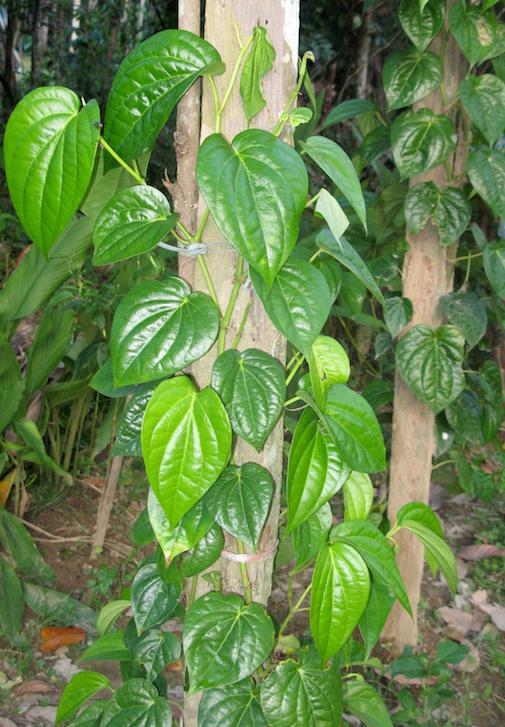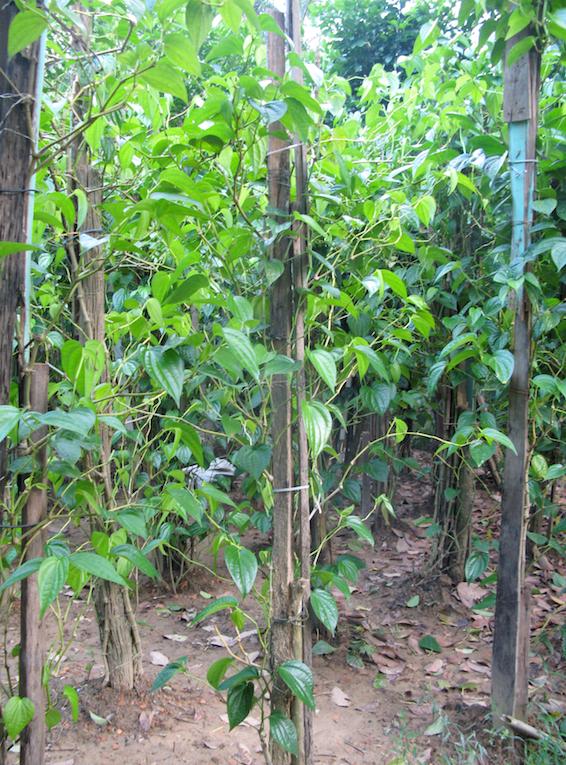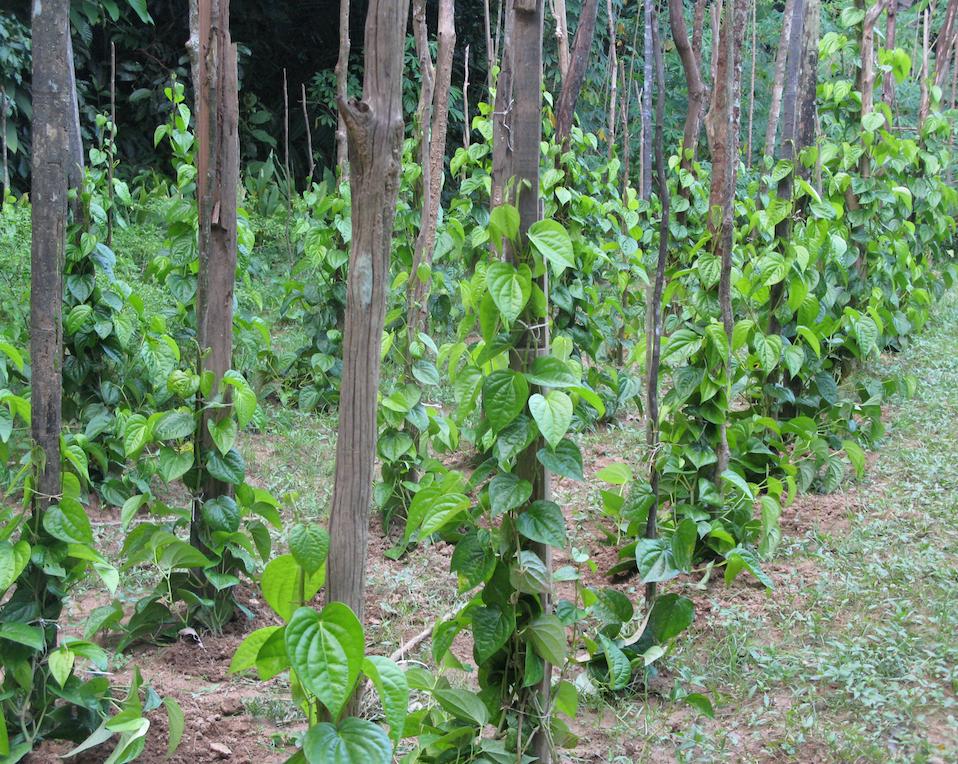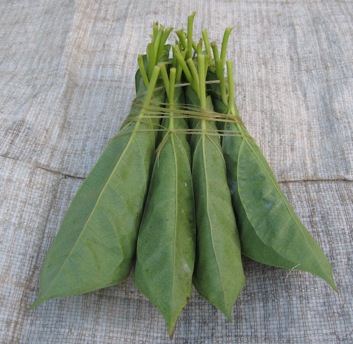Botanical Names
Piper betle L.
Common Names
| Malaysia | Sirih |
| English | Piper betle |
| Indonesia | Sirih |
| Thailand | Plue |
| Philippines | Ikmo |
| Vietnamese | Trau |
| India | Paan, vetrilai, tamalapaku, vetilla |
Family
Piperaceae
Introduction
‘Sirih’ (betel) is the leaf of a vine belonging to the Piperaceae family. Other plant species that are closely related to betel are pepper and kava. The plant originated from South East Asia and South Asia that is India, Sri Lanka and Bangladesh. The plant is valued both as a mild stimulant and other medicinal properties. In Malaysia, it is planted on a small-scale basis and consumed mostly by the Indians.[1]

Morphological Features
‘Sirih’ is a perennial creeper having branching vines and can grows up to 5 metres high on a compatible tree or a pole for support. It has a similar growth habit to that of pepper. Without the support system it will grow as an understory ground cover. It has shinny dark green colour heart shape leaves measuring about 12 cm wide and 20 cm long. The leaf is singular with a short petiole.[1]

Medicinal Properties and Usage
The leaves have been used as a remedy for stomach ailments, infections, toothache, inflammations, arthritis, joint pains, worm infections and headaches. It is traditionally chewed in combination with the betel nut as stimulant. In Ayurvedic medicine, chewing with areca nut is a good remedy against bad breath. It is also believed to have aphrodisiac, immune boosting and anticancer properties. The leaves are also used to cure indigestion, tropical cure for constipation, as a decongestant and as an aid to improve lactation.[1][2][3][4][5]
Soil Suitability and Climatic Requirement
The plant is suited to the warm humid tropical climate and found to be too tender to grow outside the tropics. It best grown on well-drained soils with high organic matter contents. It requires about 20-30% shade for maximum crop growth. The plant needs about 2,000 to 3,000 mm of annual rainfall.[1]
Field Preparation
Land Preparation
The planting area must be rotovated to improve the soil structure and eliminate the weeds. The first rotovation is also done to prepare the area for liming activity if the pH of the area is low (acid soil). The second ploughing must be carried out after application of the liming material to ensure the material is well incorporated into the soil to obtain the optimum effect.[1]
Production of Planting Materials
Stem cuttings are used to propagate the plant. The stem cuttings having 3-4 internodes will starts to produce new shoots after 8 weeks after sowing. The germinated cuttings are then ready for field planting when the newly germinated shoots are about 4-5 cm. These planting materials should be raised under shade and gradually exposed to full sunlight when it is ready for ready for field planting.[1]
Field Planting
The recommended planting distance is 2.5 m between rows and 2 m between plants in the row. This will give the population density of about 2,000 plants/ha. The long planting poles or compatible trees are required since it is a creeping herb.[1]

Field Maintenance
Fertilisation
Organic and inorganic fertilisers are usually applied in ‘sirih’ cultivation. The organic manure (chicken dung) at the rate of 5-8 t/ha is incorporated into the planting bed about 7 days before planting. The compound fertiliser NPK Green (N:P:K = 15:15:15) at the rate of 800 kg/ha should be given at 6 months intervals.[1]
Weed Control
The weeds are normally controlled manually by using grass cutters during the initial stages of crop growth. The organic mulch such as dry grasses are given around the planting points to control weeds. The mulch also helps to conserve moisture and reduce the soil temperature, especially during the drier months. Very minimal weed problem is observed when the plants are fully developed.[1]
Water Management
The plant requires constant moist soil, but not water logged for maximum foliar growth. Hence, frequent light irrigations are given. The quantity of irrigation water should be such that the standing water should not remain for more than half an hour in the bed. If water logging by heavy rains or excess irrigation occurs, drainage should be arranged immediately. The best time for irrigation is morning or evening.[1]
Pest and Disease Control
Currently, there are no serious pest and disease problems on the field planting of ‘sirih’.[1]
Harvesting
The leaves of the plant are ready to be harvested at about 12 months from planting. At this stage the plant will grow to about 300-400 cm on the pole or support plants. Harvesting are normally done at two weeks intervals and lasts for several years. The leaves are tied in a bundle of about 40 leaves each. The potential yields of the leaves are about 19,000 bundles/year.[1]

Postharvest Handling
Running water should be used to clean the harvested ‘sirih’ leaves. It is then nicely arranged in pack of about 10 leaves. Four packs are then tied together to form a bundle. It is then immediately sent to the market.[1]
Estimated Cost Of Production
The total cost of production for a hectare of ‘sirih’ is estimated to be about RM 22,000. This includes the cost of land preparations, agriculture inputs and labour. With the fresh yield averaging 19,000 bundles/year, the cost of production is about RM1.20/bundle. The production cost was estimated based on the cost of current inputs during writing of this article.[1]
Read More
References
- Anon 2010. Kertas maklumat Penanaman sirih. Kuala Lumpur : Department of Agriculture Peninsular Malaysia (unpublished)
- Musa, Y. Azimah, K. and Zaharah, H. 2009. Tumbuhan Ubatan Popular Malaysia. Serdang : MARDI
- Kamarudin Mat-Salleh and Latiff, A. (editor). 2002. Tumbuhan Ubatan Malaysia. Kuala Lumpur : UKM
- Samy, J., Sugumaran, M. and Lee, K.L.W. 2005. Herbs of Malaysia. An introduction to the medicinal, culinary and cosmetic use of herbs. Times Edition: Kuala Lumpur
- Prajapati N. D., Purohit S. S., Sharma A. K., and Kumar T. 2003. A Handbook of Medicinal Plants – A Complete Source Book. Jodhpur : Agrobios (India)


